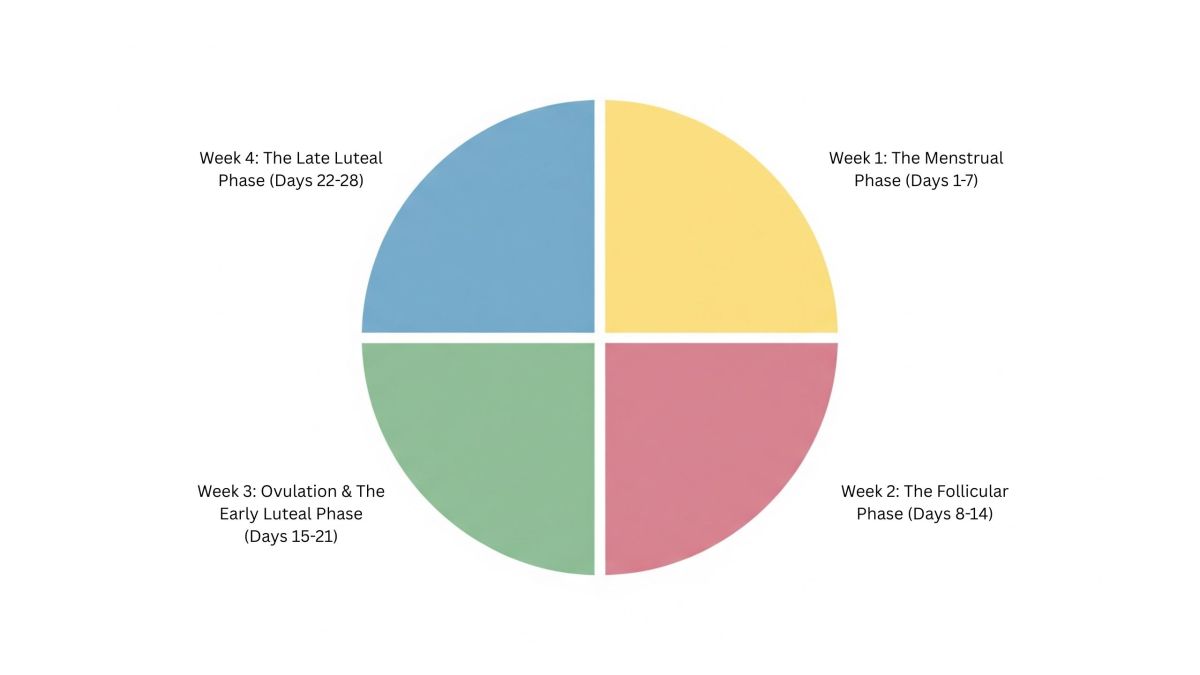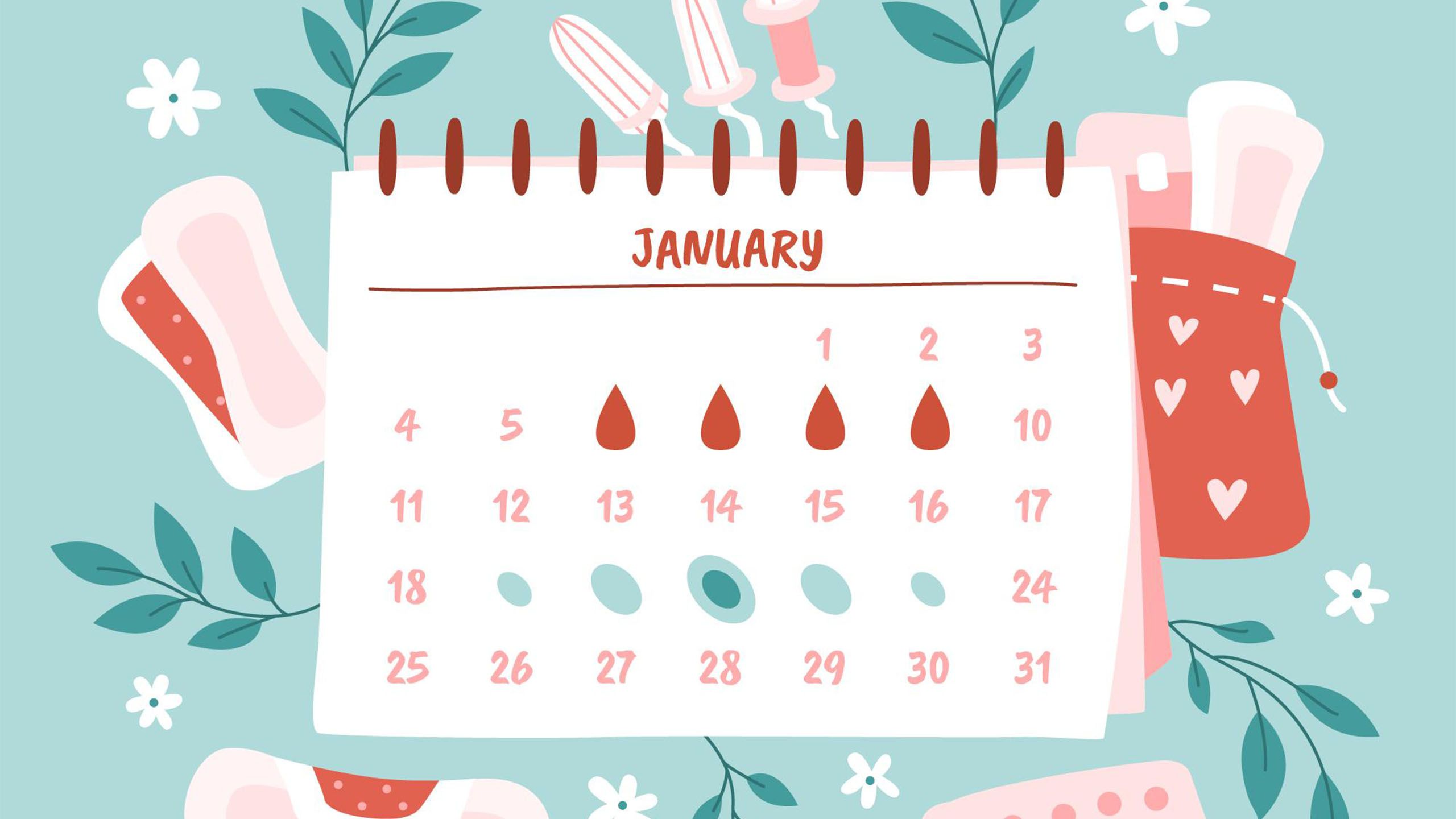Navigating Your Menstrual Cycle: A Week-by-Week Breakdown

The menstrual cycle is a fundamental process in the female body, orchestrated by a rhythmic fluctuation of hormones. While often simplified to just the period, the cycle is a month-long journey that influences everything from energy levels and mood to appetite and skin clarity. Understanding its distinct phases can provide valuable insight into your physical and mental well-being.
The average cycle lasts about 28 days, but it's important to note that variations are normal. Some cycles are shorter, others are longer, and they can change over time. This guide uses a 28-day model to break down the experience week by week, focusing on the key hormones at play: follicle-stimulating hormone (FSH), luteinizing hormone (LH), estrogen, and progesterone.
Summary of the Menstrual Cycle Phases
| Phase (Approx. Days) | Key Hormones | Common Physical Sensations | Typical Mood & Energy |
|---|---|---|---|
| Week 1: Menstrual (Days 1-7) | Estrogen & Progesterone are low. | Menstruation, cramps, fatigue, bloating. | Low energy, introspective, desire for rest. |
| Week 2: Follicular (Days 8-14) | Estrogen is rising. | Increasing energy, clearer skin, higher libido. | Optimistic, confident, social, productive. |
| Week 3: Ovulation / Early Luteal (Days 15-21) | Estrogen peaks, LH surges, Progesterone begins to rise. | Ovulation sensations, stable energy, higher body temp. | Stable mood, shifting towards calm and nesting. |
| Week 4: Late Luteal (Days 22-28) | Estrogen & Progesterone fall sharply. | PMS symptoms: bloating, breast tenderness, fatigue. | Irritability, emotional sensitivity, mood swings. |
Week 1: The Menstrual Phase (Days 1-7)
This week begins on the first day of your period. With no pregnancy from the previous cycle, levels of both estrogen and progesterone are at their lowest point.
-
Hormonal Activity: Low levels of estrogen and progesterone signal the pituitary gland to begin releasing FSH, which starts the process of maturing new follicles in the ovaries for the next cycle.
-
Physical Experience: The primary event is menstruation—the shedding of the uterine lining. This can be accompanied by cramps, bloating, lower back pain, and general fatigue. Energy levels are typically at their lowest during this week, making it an ideal time for rest and lighter activities.
-
Mind & Mood: The low hormonal state can lead to feelings of introspection or a desire to be more withdrawn. You might find your mental energy is best suited for quiet reflection rather than intense social engagement or demanding projects.
Week 2: The Follicular Phase (Days 8-14)
As bleeding subsides, the body enters a phase of growth and preparation. This week is characterized by a steady increase in estrogen.
-
Hormonal Activity: FSH stimulates the growth of ovarian follicles. One follicle becomes dominant and ramps up its production of estrogen. This rising estrogen works to thicken the uterine lining in preparation for a potential pregnancy.
-
Physical Experience: You will likely notice a significant increase in physical energy and stamina. Rising estrogen can also improve skin health, leading to a clearer complexion. Libido often begins to increase during this time, peaking around ovulation.
-
Mind & Mood: Estrogen has a positive effect on brain chemistry, often leading to an improved mood, increased optimism, and greater mental sharpness. Many women report feeling more confident, articulate, and productive during this phase. It can be a great time to tackle challenging tasks and schedule social activities.
Week 3: Ovulation & The Early Luteal Phase (Days 15-21)
This week marks the midpoint of the cycle, beginning with the main event: ovulation.
-
Hormonal Activity: The peak in estrogen triggers a sharp surge in LH, which causes the dominant follicle to rupture and release an egg. This is ovulation. Following this, the follicle transforms into the corpus luteum and begins producing progesterone, which will now become the dominant hormone for the second half of the cycle.
-
Physical Experience: Some individuals may feel a slight twinge of pain or cramping on one side of the abdomen during ovulation. After ovulation, progesterone causes a slight rise in basal body temperature. Energy levels often remain stable but may start to gently decline from the peak experienced in Week 2.
-
Mind & Mood: Mood is often still stable and positive in the days immediately following ovulation. As progesterone levels climb, you may notice a subtle shift towards a calmer, more settled state of mind. Progesterone can have a soothing effect, sometimes leading to a preference for completing tasks and focusing inward.
Week 4: The Late Luteal Phase (Days 22-28)
If the egg is not fertilized, the body begins preparing to start the cycle all over again. This week is known for the onset of premenstrual symptoms (PMS).
-
Hormonal Activity: The corpus luteum begins to break down, causing a rapid decline in both progesterone and estrogen. This hormonal drop is the primary trigger for premenstrual symptoms and the period itself.
-
Physical Experience: This is when symptoms like breast tenderness, bloating, headaches, fatigue, and food cravings are most common. Sleep may also be affected.
-
Mind & Mood: The drop in hormones can impact brain neurotransmitters, such as serotonin, potentially leading to mood swings, irritability, anxiety, or increased emotional sensitivity. It is a natural time to prioritize self-care, reduce stress, and engage in gentle exercise like walking or stretching.
Understanding Your Personal Rhythm
This week-by-week guide provides a general framework for the hormonal changes that occur during the menstrual cycle. However, every person's experience is unique. Tracking your own cycle and making notes on your energy, mood, and physical sensations can help you better understand your personal patterns. This awareness allows you to work with your body's natural rhythms, providing a clearer picture of your overall health. If you have significant concerns about your cycle, such as severe pain or irregular periods, it is always best to consult with a healthcare professional.
Disclaimer: The articles and information provided by the Vagina Institute are for informational and educational purposes only. This content is not intended to be a substitute for professional medical advice, diagnosis, or treatment. Always seek the advice of your physician or another qualified health provider with any questions you may have regarding a medical condition.


 English
English  Deutsch
Deutsch  Español
Español  Français
Français 


